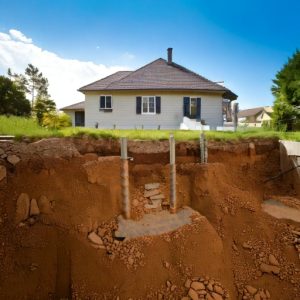When it comes to foundation issues, no two homes are alike. The size, style, and age of your home can all play a significant role in how foundation problems manifest and what repairs are necessary. From sprawling mansions to charming cottages, each type of home faces unique challenges when it comes to its foundation. Understanding these differences can help homeowners better anticipate potential issues and make informed decisions when it comes to maintenance and repairs.
The Foundation of Larger Homes: Mansions and Multi-Story Homes
1. More Complex Foundation Systems
Larger homes typically have more complex foundation systems to support the increased weight of the structure. Mansions or multi-story homes often rely on deep foundations, such as pier and beam or full basement foundations. These systems are designed to distribute the load more evenly but are also more prone to shifting due to uneven soil, excessive moisture, or other environmental factors.
2. Settlement Risks
With the sheer size of the structure, even small shifts in the ground beneath a mansion can lead to significant settlement issues. Larger foundations may experience uneven settling if the soil is unstable or improperly compacted during construction. This can cause cracks in walls, doors that won’t close properly, or floors that appear uneven.
3. Increased Vulnerability to Soil Movement
Mansions often have expansive yard space, which may increase exposure to varying soil conditions. Expansive clay soils, for example, can swell with moisture and shrink when dry, causing movement beneath the foundation. This is particularly common in regions like Lawrence, KS, where the soil conditions can fluctuate greatly with the seasons.
4. Foundation Repair Complexity
The larger the home, the more complicated and expensive repairs tend to be. For example, repairing a cracked foundation in a multi-story home may involve additional shoring up or even excavation, depending on the severity of the problem. Specialized equipment is often required to access different parts of the foundation without damaging the surrounding structure.
Smaller Homes: Cottages and Single-Story Residences
1. Simplified Foundation Design
Smaller homes, such as cottages or single-story residences, tend to have simpler foundations. These homes often use slab-on-grade or crawl space foundations, which are less complex but can still face issues like cracking or shifting over time. These foundations are easier to repair but can still suffer from soil movement, poor drainage, or moisture infiltration.
2. Less Exposure to Settlement
Cottages and smaller homes are less likely to experience significant settlement issues because they exert less weight on the ground beneath them. However, even minor soil shifts can still lead to noticeable cracks in walls, floors, or ceilings. Since these homes are generally lighter, the impact of settlement is less dramatic than in larger, heavier homes, but it still requires attention.
3. Easier to Monitor
With less square footage and fewer structural components, it’s easier for homeowners of smaller homes to spot the early warning signs of foundation issues, such as small cracks in walls or floors that are a result of settling. While larger homes might require more in-depth inspections, smaller homes can be assessed more frequently and at a lower cost.
4. More Affordable Repairs
Repairs for smaller homes are generally less expensive because the foundation system is less intricate and the work required is less extensive. However, if issues are left untreated, they can still escalate into more significant problems. For instance, a crack in a cottage’s crawl space might lead to moisture damage or mold growth, which can compound the original foundation issue.
How Different Foundations Handle Local Soil Conditions
1. Expansive Soils and Larger Homes
In areas with expansive clay soils, such as in Lawrence, KS, large homes built on pier and beam foundations or full basements face significant challenges. These homes are more susceptible to soil movement, which can cause foundation instability. Proper moisture control around these larger foundations is crucial to prevent the soil from swelling or shrinking excessively, leading to cracks and shifts in the structure.
2. Shifting and Settling in Smaller Homes
While smaller homes may not be as heavy, they are still affected by shifting soil, particularly in areas with unstable or sandy soils. For example, a cottage built on a slab foundation can experience cracks in the concrete if the soil beneath the slab shifts or erodes. Regular maintenance of drainage systems and ensuring proper grading can help minimize these risks.
Foundation Solutions for Different Home Sizes
1. Underpinning for Larger Homes
In mansions or multi-story homes, one of the most common repair techniques is underpinning—a method of strengthening the foundation by extending it deeper into more stable soil or adding additional piers for support. This can be a complex and expensive process but is necessary for homes that are experiencing significant settlement or structural issues.
2. Slab Foundation Repairs for Smaller Homes
For smaller homes, repairing a slab foundation typically involves filling cracks with epoxy or polyurethane injections to prevent further water damage. These repairs are usually less invasive and can be done quickly, but it’s important to address underlying issues such as poor drainage or soil erosion to avoid future problems.
3. Crawl Space Ventilation and Moisture Control
For homes with crawl spaces, whether large or small, ensuring proper ventilation and moisture control is critical to maintaining a healthy foundation. Installing a vapor barrier or using dehumidifiers can help reduce the risk of mold and water damage, which can weaken the foundation over time.
Conclusion
When it comes to foundation issues, size and style truly matter. Larger homes like mansions face more complex foundation challenges due to their weight, complexity, and exposure to shifting soils. On the other hand, smaller homes, while not as heavy, still require vigilant monitoring and care to prevent foundation damage from soil movement and moisture issues. Regardless of the size or style of your home, understanding the specific risks and taking proactive measures can ensure the long-term stability of your foundation and home. Whether you live in a sprawling estate or a cozy cottage, regular maintenance, proper drainage, and timely repairs are the keys to keeping your home on solid ground.






